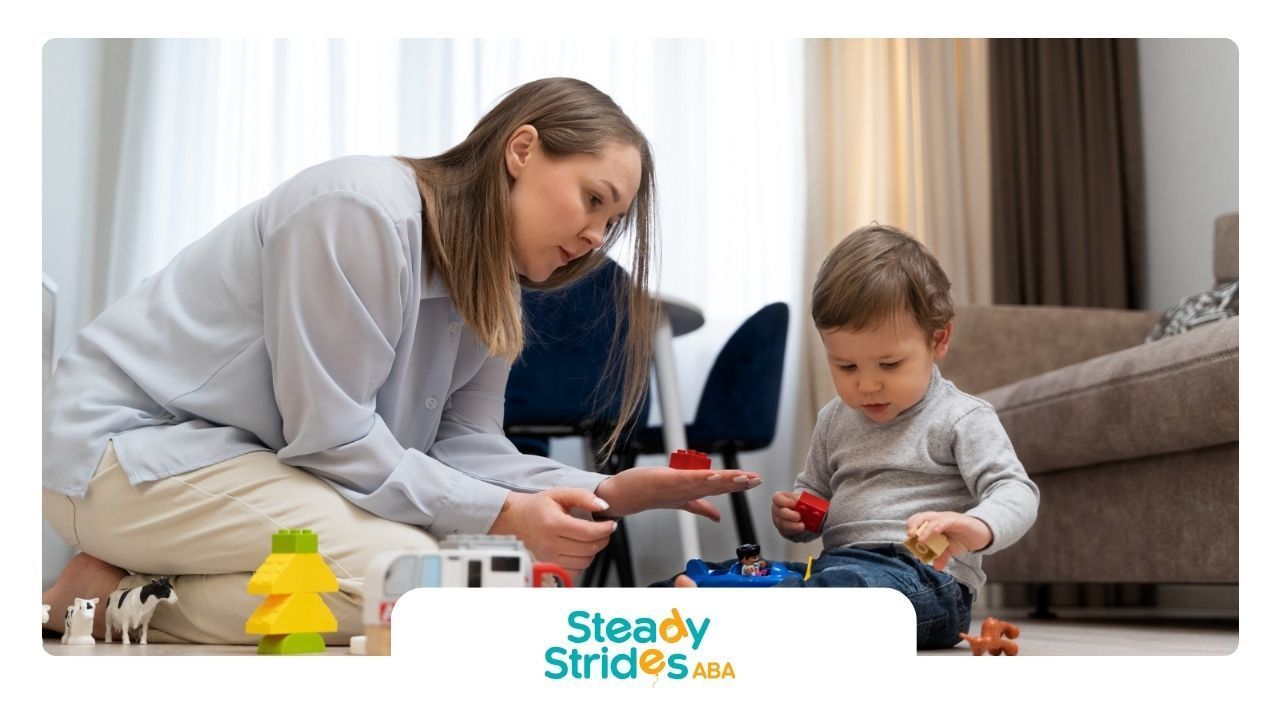For people with autism spectrum disorder (ASD), social interaction can be tough. They often face challenges when it comes to communication. These issues can continue into adulthood. This affects their social connections, relationships, and overall happiness. This blog post will share useful strategies and ideas to improve communication skills for autistic adults.
Autism and Communication Difficulties in Adults
Navigating social communication can feel confusing for people with autism spectrum disorder. Their language use may be different. This can create communication problems due to varied interpretations of social cues and body language. Some autistic adults might be great in areas like visual or factual communication. However, others may struggle with understanding sarcasm, reading body language, or keeping a conversation going.
It is important to remember that these differences in communication do not mean that they are less intelligent or do not want to connect. These differences come from how their brains process social information. Acknowledging the different ways autistic adults communicate is key to creating understanding, empathy, and strong connections.
Why do Autistic People Struggle with Communication?
Communication challenges for autistic individuals come from different factors involving social cues, language skills, and how they process sensory information. A big challenge is understanding nonverbal cues like facial expressions, tone of voice, and body language. This can often lead to misunderstandings in social situations.
Besides that, filtering sensory input can make communication harder. Autistic individuals might feel overwhelmed in places with loud noises, bright lights, or strong smells. This sensory overload makes it tough to focus on and understand spoken language.
Also, autistic individuals tend to take language literally. This can make it hard for them to understand figurative speech, sarcasm, or jokes. This tendency can cause confusion and misinterpretations during conversations, which complicates social interaction even more.
Strategies to Enhance Communication Skills in Adults with Autism
Many strategies can help improve communication skills in autistic adults. These strategies focus on building supportive environments, using visual aids, and applying methods that fit the needs of each person. It's important to be patient and keep working on these strategies.
When we understand the communication challenges related to autism and use the right techniques, we can help autistic individuals express themselves better and build strong connections.
1. Encouraging Non-Verbal Communication Techniques
Developing new communication techniques can help close communication gaps. Autistic individuals often find traditional ways of communicating, like facial expressions and eye contact, hard. Looking into different ways to communicate can be very helpful. Here are some methods to think about:
- Visual aids and picture cards: Using tools like picture cards to show objects, actions, or feelings can help a lot, especially for those who learn visually.
- Sign language: Learning simple sign language or gestures can be a great tool for sharing needs and having conversations, especially when talking is hard.
- Technology-based communication: Using tablets or smartphones with communication apps can give many options for expressing thoughts. These apps can be simple picture systems or more advanced speech-generating software.
By using these alternative communication methods, autistic individuals can share their thoughts better. This can lead to less frustration and help them join in social situations more meaningfully.
2. Utilizing Technology and Visual Aids for Better Understanding
Technology and visual supports are important tools for helping autistic adults communicate better. Visual supports include pictures, diagrams, and written words. They can make messages clearer, help with understanding, and improve communication by reducing the use of abstract language. Here are some ways to use visual supports:
- Social stories: You can create personalized social stories with text and pictures. This can help autistic individuals understand and manage different social situations.
- Visual schedules: Using pictures or symbols for visual schedules adds structure to daily routines. This helps to ease anxiety and makes transitions smoother.
- Tablets and apps: Tablets with communication apps allow autistic adults to share their needs and thoughts effectively, even if they struggle with speech.
By using these visual aids in communication strategies, we can help create a more supportive environment for autistic individuals.
3. Developing a Routine for Communication Practice
Building a routine for communication practice is very important. It helps improve social skills and confidence. Having a regular practice in a safe and organized space lets autistic adults use their communication skills in real-life situations. This can include:
- Role-playing: Acting out different scenarios with a communication partner can help practice specific social situations. Examples are starting conversations or sharing feelings.
- Structured conversations: Setting specific times for structured talks about specific topics can help encourage comfortable communication.
- Utilizing visual schedules: Using visual schedules can assist in planning and getting ready for these practice sessions. This makes them easier and less stressful.
By adding regular communication practice to their daily routines, autistic adults can improve their social interaction skills and feel more confident in social situations.
4. Engaging in Social Skills Training Programs
Participating in social skills training programs led by skilled social skills therapists can really help autistic adults. These programs offer a safe and organized space for people to learn and practice important social skills with others. These programs usually include:
- Group discussions and activities: Being part of group discussions and activities helps individuals watch and learn from one another while practicing social interaction in a safe environment.
- Video modeling: This method uses video to show social interactions. Watching these videos can be extra helpful for those who learn better through visuals.
- Real-life practice: Moving from structured activities to real-life practice in the community helps use the skills learned in everyday situations.
With support from trained therapists in these programs, autistic adults can better understand social interactions and feel more confident when facing social situations.
5. Implementing Speech Therapy Techniques Tailored for Autism
Speech therapy, guided by skilled speech therapists, can help improve communication and language skills for autistic adults. Each therapy session is custom-made to meet individual needs. The focus is on improving both how they speak and how they understand language. Speech therapy may include:
- Articulation and pronunciation exercises: These activities help make speech clearer and tackle issues with sounds and combinations of sounds.
- Vocabulary-building activities: Using games, visual aids, and fun activities can help build vocabulary. This helps individuals share their thoughts more effectively.
- Pragmatic language training: This part of therapy works on the social use of language. It helps with understanding idioms, reading nonverbal cues, and taking turns during conversations.
Overcoming Common Communication Barriers
When we work on ways to improve communication, we must also look at common barriers that make it hard for autistic adults to communicate well. These barriers include sensitivity to sounds or lights, trouble speaking their thoughts, and difficulty understanding nonverbal cues like body language.
By noticing these barriers and tackling them directly, we can help create better social interactions for autistic individuals.
Identifying and Addressing Sensory Sensitivities
Sensory overload can make it hard for autistic individuals to communicate. It is important to understand their sensitivities. This helps in making a better communication environment. For example, some people cannot handle loud noises. This can make it tough for them to have conversations in places that are busy or noisy.
Adjusting communication methods to reduce sensory overload can improve interactions a lot. Using noise-canceling headphones or finding quieter spaces can cut down distractions. This helps make talking easier. People who are sensitive to bright lights may also do better in areas with softer lighting.
By paying attention to triggers and making changes, we can provide environments that are aware of sensory needs. This can help autistic individuals communicate effectively.
Strategies for Improving Verbal Communication
Improving how autistic adults talk involves knowing their unique use of language. It’s important to change our communication styles to help them understand us better. Using clear and short words, without idioms or tricky phrases, can really help.
Keep in mind that autistic individuals may communicate in different ways, and that’s perfectly fine. Echolalia is when someone repeats words or phrases. This is common in autism. It can be used for different reasons, like helping themselves stay calm or asking for something. Instead of stopping it, try to see why they are doing it.
Being patient, listening actively, and giving gentle help can boost an autistic individual's confidence. It can make them more likely to talk. Celebrate small successes and focus on what they achieve instead of aiming for perfection.
Enhancing Understanding of Body Language and Facial Expressions
Navigating body language and facial expressions can be hard for autistic adults. Nonverbal cues that neurotypical people often read easily may not mean the same to someone with autism.
Teaching common body language signals can help. For example, a raised eyebrow might show surprise, while crossed arms often mean defensiveness. Role-playing can also help those practicing recognize and respond to these cues.
Using visual aids, like charts of different facial expressions and emotions, is a good idea. By clearly teaching these aspects of nonverbal communication, we can help autistic adults understand and manage social situations better.
The Role of Caregivers and Professionals in Communication Development
Caregivers and professionals are important in helping autistic adults improve their communication skills. It is vital to create a supportive environment that promotes communication and offers the right therapies and resources.
Working together with therapists, family members, and, most importantly, the autistic adult is key to coming up with and carrying out good communication strategies. Being open about needs and understanding each other is the basis for success.
Creating a Supportive Environment for Communication Growth
Creating a supportive environment is very important for helping autistic individuals develop their communication skills. This means making a place where they can feel safe to share their thoughts without worrying about being judged. It also involves giving them the tools and help they need to deal with communication challenges.
Start by being patient and understanding. Remember that communication differences are not purposeful. These differences show how their brains work. Don’t interrupt or rush them. Give them enough time to think and share their ideas.
Aim to grow their confidence by recognizing their attempts and celebrating their successes. A supportive environment allows autistic individuals to communicate naturally and engage in social situations with more ease and confidence.
Collaboration Between Therapists, Families, and Individuals
Effective communication support for autistic adults requires everyone to work together. This includes therapists, families, and most importantly, the person themselves. Open talks and shared goals are key. They help us create strategies that fit the unique needs and preferences of each person.
Therapists can help shape social skills training programs. They can also design personal communication plans. Families play a big role too. They can support these plans at home and give chances for practice in daily life. The active involvement of the individual is crucial. They understand their own communication style and challenges best.
When therapists, families, and individuals collaborate, they build a strong network. This network encourages communication growth. It helps autistic adults connect better with their social world.
Conclusion
To sum up, how to improve communication skills in autism adults with autism needs a mix of methods. This includes using non-verbal techniques, technology tools, regular practice, social skills training, and customized speech therapy. It's important to overcome challenges like sensitivity to sounds and understanding body language. Caregivers and professionals are key in making a supportive environment for better communication. They can work together and create fit strategies. By doing this, people with autism can enhance their communication skills and enjoy more fulfilling lives.
Steady Strides ABA specializes in providing comprehensive ABA therapy services to help individuals with autism develop essential communication skills. Our experienced therapists create individualized treatment plans that address specific communication challenges and build confidence. With a focus on evidence-based practices and a commitment to lifelong learning, we empower individuals to connect with the world around them. Contact Steady Strides ABA today to learn more about our best ABA therapy services in Texas and how we can support your journey.
Frequently Asked Questions
How do you talk to a high-functioning autistic adult?
When you talk to a high-functioning autistic adult, be direct, honest, and clear. Don't use sarcasm, as it may be confusing. Remember that they may struggle with small talk and social cues. Focus on having direct and meaningful conversations.
What are some effective communication aids for adults with autism?
Effective communication tools that help adults with autism include visual aids, like picture cards and schedules. AAC (augmentative and alternative communication) devices, such as tablets with communication apps, are also useful. Additionally, visual information, including written instructions and social stories, can improve communication.
How can caregivers support the development of communication skills?
Caregivers can help grow communication skills. They can do this by talking often, giving chances for functional communication, using visual supports, and working with therapists. These actions can lead to better results through customized strategies.
Can adults with autism improve their communication skills later in life?
Yes, adults with autism can get better at communicating as they grow older. They can learn throughout their lives. This can happen through speech therapy, social skills training, and continuous support.












